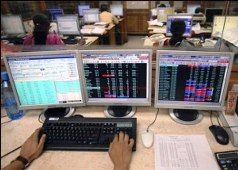 Beyond the absolute fall in benchmark indices, the pain for foreign institutional investors is deep.
Beyond the absolute fall in benchmark indices, the pain for foreign institutional investors is deep.
While the benchmark indices may only be 11-15 per cent off their all-time highs, the dollar value of holdings at the peak has fallen by half or even three quarters.
In fact, the value of the Sensex adjusted for the relative loss in the rupee’s value is close to levels previously seen in early 2009.
A foreign investor who had holdings worth $100 in November 2010 or January 2008 (the last two times the market peaked near 21,000) would now be worth $43 and $26, respectively.
The Sensex has fallen 11.65 per cent since its all-time high of 21,004.96 in November 2010; the rupee has fallen 45.44 per cent since then.
So, while in absolute terms, the Sensex has only dropped to 18,558.13, for a foreign investor, the losses are about 57 per cent.
Adjusted for the fall in the currency, the equivalent Sensex value of his holdings is sub-10,000.
The previous high of the Sensex was January 8, 2008, at the peak of the bull-run; it hit a closing high of 20,873.33.
The Sensex has fallen 11.09 per cent in absolute terms.
At that time, the rupee’s exchange rate against the dollar was 39.27.
Relative to the dollar, it has lost 63.73 per cent.
The Sensex value adjusted for the rupee’s fall is sub-6,000.
So far this year, foreign institutional investors have been net buyers by Rs 61,583 crore (Rs 615.83 billion), though they have been net sellers by Rs 19,633.4 crore (Rs 196.33 billion) in the last
Prateek Agrawal, chief investment officer at ASK Investment Managers, said FII outflows have been limited because of allocations and redemptions.
“Allocations do not change more than once or twice a year and we had seen some amount of inflows into emerging market funds in recent times.
“Also, these fund managers have not faced redemption pressure so far, except in a small way,” he said.
Agrawal estimates the market capitalisation-to-gross domestic product, or the value of listed companies compared to the country’s economic output, is close to levels seen in 2004-05.
Hitendra Dave, managing director and head (global markets), India, at HSBC Global Banking and Markets, said the sentiment abroad was better than in India.
“The sentiment among FIIs is not as bad as it is locally.
Perhaps, they have the perspective that while India’s growth is going to be weak and the currency under pressure, it is not just unique to India as an economy.
Having said that, people are looking for a bit of stability in the exchange rate market to make further investment/disinvestment decisions,” he said.
The S&P BSE Dollex-30, an index which measures the change in the Sensex in dollar terms, has fallen to 2,375.64, a 23 per cent decline from its 52-week high of 3,095.06.
Rupee loss changes the game
• Sensex has fallen less than 12 per cent from its all-time high in November 2010
• But relative value of rupee against the dollar has fallen 45 per cent
• Sensex value adjusted for currency is below 10,000
• Equivalent figure from Jan 2008 level is sub-6,000












 © 2025
© 2025